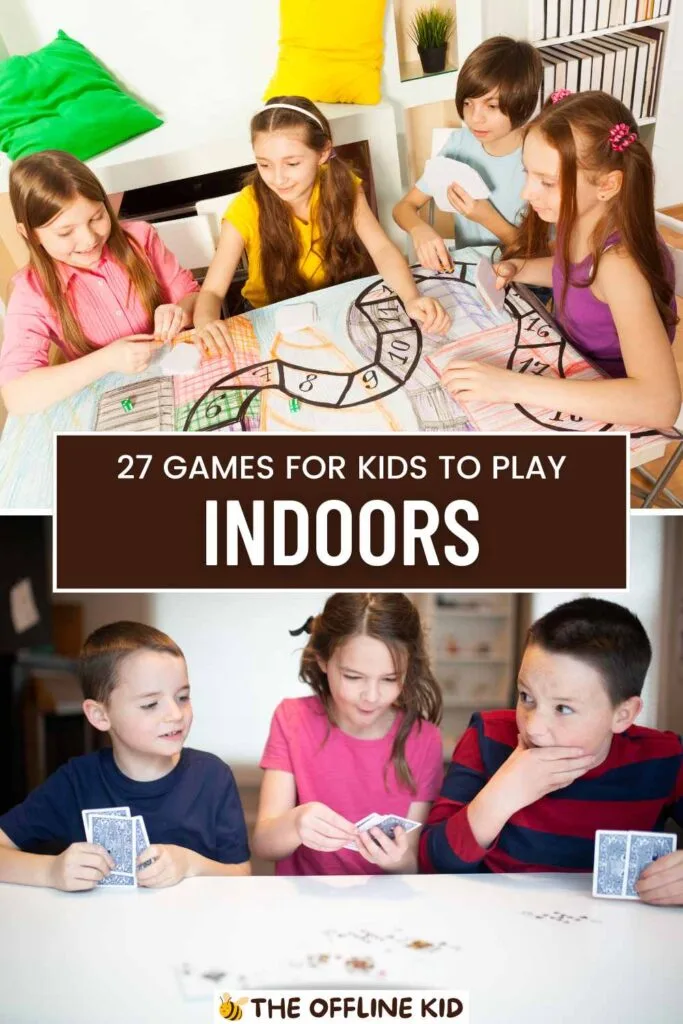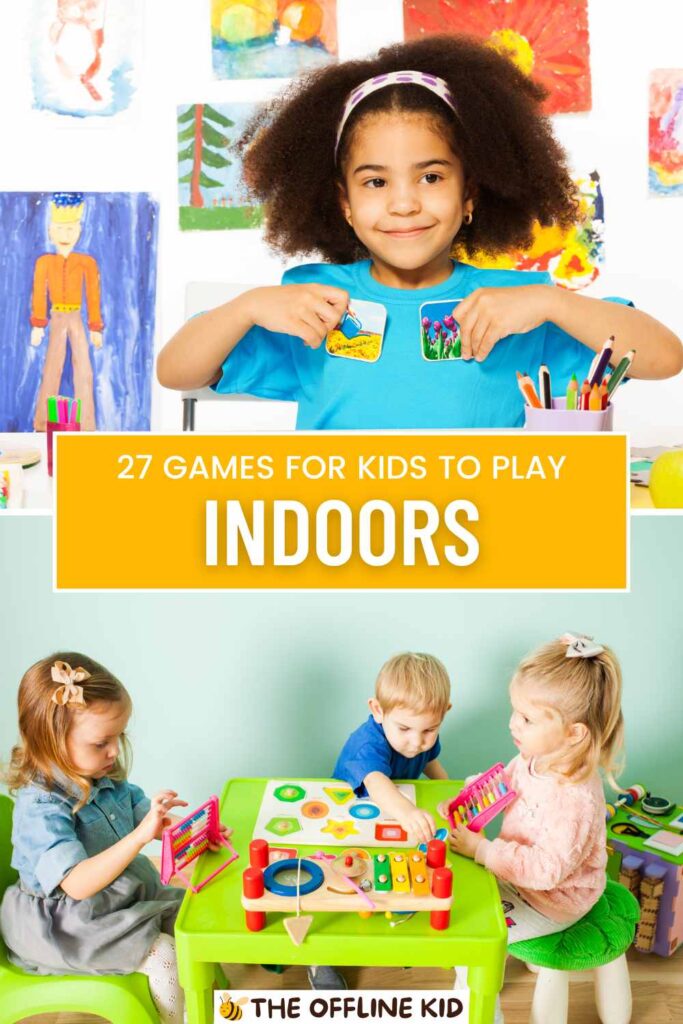Keeping kids entertained indoors can be a challenge, but it doesn’t have to be!
Our ultimate guide offers a variety of fun and engaging indoor games that promote creativity, physical activity, and family bonding.
From classic games to imaginative play, there’s something here for every child.
Classic Indoor Games
Hide and Seek
Hide and Seek is a timeless game that never gets old. It’s simple, requires no special equipment, and can be played by kids of all ages.
- Rules:
- One person is designated as “It” and closes their eyes to count to a predetermined number while the other players hide.
- Once counting is done, “It” searches for the hidden players.
- The first person found becomes “It” for the next round.
- Variations:
- Sardines: Only one person hides, and everyone else searches. When a searcher finds the hider, they join them in the hiding spot until only one seeker remains.
- Hide and Seek in the Dark: Play with the lights off (safety first – make sure the area is free of hazards).
Simon Says
Simon Says is a great game for developing listening skills and following instructions.
- How to Play:
- One person takes the role of “Simon” and gives commands starting with “Simon says…”
- Players must only follow commands prefixed with “Simon says.”
- If “Simon” gives a command without saying “Simon says,” players should not follow it. Those who do are out.
- Fun Commands and Variations:
- Commands: Touch your toes, jump three times, spin around, pat your head.
- Variations: Add silly commands or make it a speed challenge.
Musical Chairs
Musical Chairs combines music with quick reflexes and is always a hit at parties and gatherings.
- Setting Up the Game:
- Arrange chairs in a circle, with one less chair than the number of players.
- Play music while players walk around the chairs.
- When the music stops, players must quickly sit in a chair. The one left standing is out, and a chair is removed.
- Repeat until one player remains.
- Variations to Keep It Exciting:
- Reverse Musical Chairs: Instead of removing chairs, add them so that every round, there’s an extra chair, and the last player standing wins.
- Freeze Dance Musical Chairs: Combine the game with Freeze Dance. Players must freeze when the music stops, and then find a chair.
Classic games like these offer a blend of excitement and simplicity, ensuring that kids stay engaged while having a blast. They are perfect for family gatherings, playdates, or any time kids need a fun and active indoor activity.
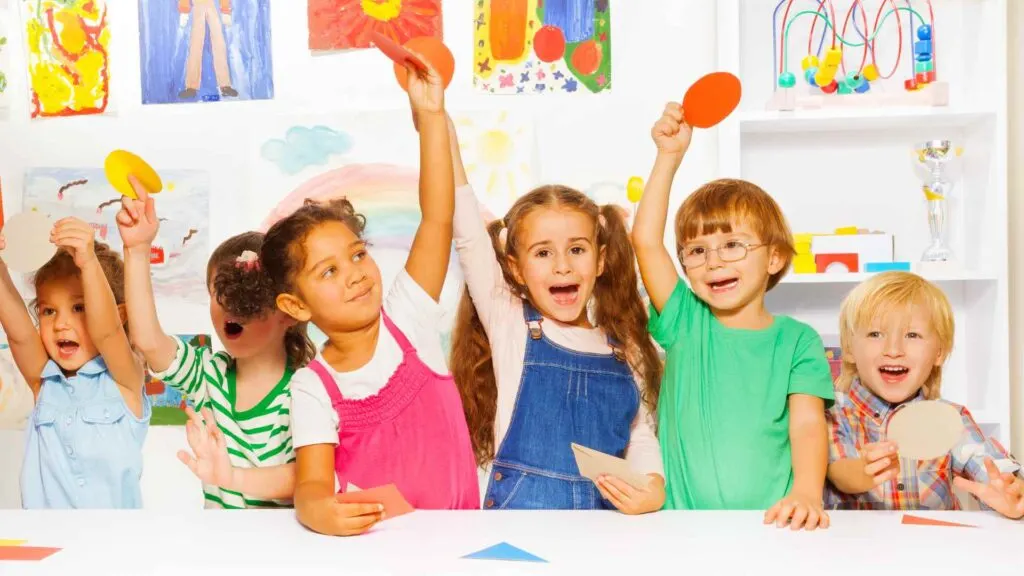
Creative and Imaginative Play
Indoor Camping
Transform your living room into a campsite and let your kids’ imaginations run wild.
- Setting Up a Campsite:
- Use blankets and pillows to create tents or forts.
- Bring out sleeping bags or create makeshift ones with blankets.
- Use flashlights for a campfire effect and tell stories around it.
- Activities to Do in the “Camp”:
- Storytelling: Share spooky or funny stories.
- Camping Snacks: Make s’mores in the microwave or have a picnic with easy-to-make snacks.
- Nature Crafts: Use leaves, sticks, and rocks collected from outside to create nature-themed art.
Pretend Play
Encourage creativity and role-playing with various dress-up ideas and scenarios.
- Dress-Up Ideas:
- Superheroes, pirates, fairies, animals, and more.
- Use old clothes, costumes, and props from around the house.
- Scenarios and Storylines:
- Supermarket: Set up a pretend grocery store with items from the pantry.
- Doctor’s Office: Use toy medical kits and stuffed animals as patients.
- Restaurant: Create menus, set up tables, and take turns being the chef and customers.
Puppet Shows
Puppet shows are an excellent way for kids to express themselves and put on a performance.
- Making Puppets:
- Use socks, paper bags, or craft supplies to create puppets.
- Decorate with markers, buttons, yarn, and other craft items.
- Creating a Stage and Story:
- Use a cardboard box or a table with a cloth draped over it as the stage.
- Help kids come up with a storyline or let them improvise their own show.
- Invite family members to be the audience and enjoy the performance.
Imaginative play allows children to explore new roles and scenarios, enhancing their creativity and problem-solving skills. These activities provide endless opportunities for fun and learning, making any indoor playtime more enriching and enjoyable.
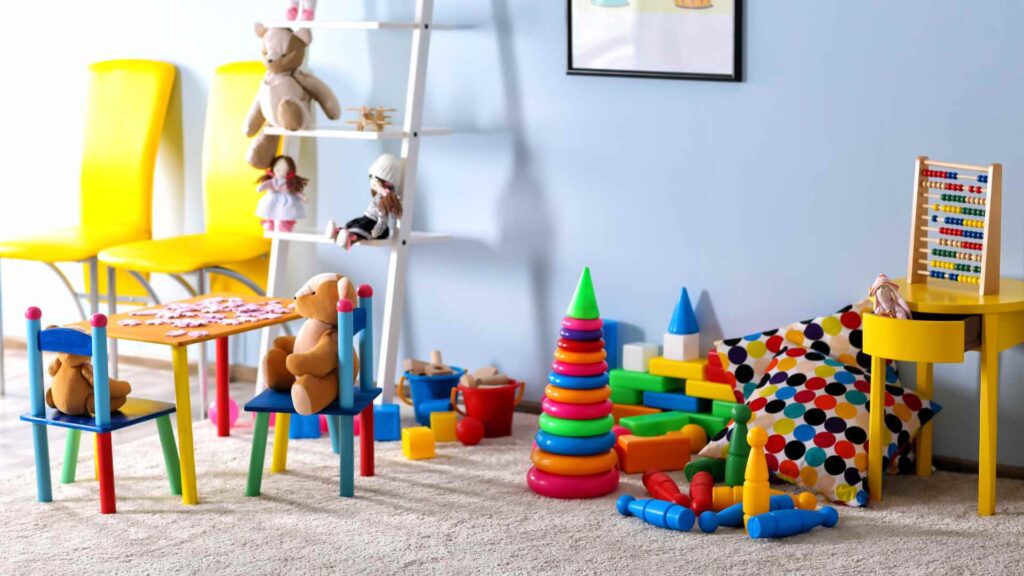
Active Indoor Games
Indoor Obstacle Course
Create a fun and challenging obstacle course right in your living room.
- Setting Up a Safe and Fun Course:
- Use pillows, chairs, and furniture to create obstacles.
- Mark a starting point and a finish line with tape or objects.
- Ideas for Different Obstacles:
- Crawl Under: Use chairs or tables that kids must crawl under.
- Jump Over: Place pillows or cushions that kids must jump over.
- Balance Beam: Use a long piece of tape or a narrow board for balancing.
- Tunnel: Create a tunnel with a blanket draped over chairs.
Balloon Volleyball
Balloon volleyball is a great way to get kids moving without the risk of breaking anything.
- Rules and Setup:
- Use a balloon instead of a ball to prevent damage.
- Create a “net” using a piece of string or a strip of tape on the floor.
- Divide players into two teams and volley the balloon back and forth over the net.
- Variations for Added Fun:
- Sitting Volleyball: Players must stay seated while playing.
- Different Balloons: Use balloons of different sizes or fill them with different amounts of air for variety.
Freeze Dance
Combine music and movement with Freeze Dance, a game that keeps kids active and entertained.
- How to Play:
- Play upbeat music and let kids dance around.
- When the music stops, everyone must freeze in place.
- Anyone who moves while the music is off is out, and the last person dancing wins.
- Playlist Suggestions:
- Create a playlist of kids’ favorite songs.
- Use songs with varying tempos to make freezing more challenging.
Active indoor games like these help burn off energy and keep kids physically engaged, even when they can’t go outside. They are perfect for rainy days or any time kids need a fun way to stay active indoors.
Board Games and Card Games
Family-Friendly Board Games
Board games are a fantastic way to bring the family together for some friendly competition and strategic thinking.
- Top Recommendations for Different Age Groups:
- Young Children (3-5 years):
- Candy Land: A simple game with colorful graphics.
- Chutes and Ladders: Easy to understand and play.
- School-Age Kids (6-10 years):
- Connect 4: Encourages strategic thinking.
- Operation: Fun and develops fine motor skills.
- Tweens and Teens (11+ years):
- Catan: Engages in resource management and strategy.
- Clue: A classic mystery game.
- Young Children (3-5 years):
- Tips for Engaging Play:
- Rotate Games: Keep things fresh by rotating different games.
- Game Night Themes: Create themed game nights, like “mystery night” or “retro games.”
- Family Tournament: Organize a tournament with a prize for the winner.
Card Games
Card games are versatile, portable, and perfect for quick rounds of fun.
- Simple Card Games for Young Kids:
- Go Fish: Easy for kids to learn and play.
- Old Maid: Fun and helps with matching skills.
- More Complex Games for Older Kids:
- Uno: Engaging and colorful game that combines strategy and luck.
- Crazy Eights: A fast-paced game that keeps kids on their toes.
Board games and card games provide hours of entertainment and help develop various skills such as strategic thinking, memory, and teamwork. They are excellent for family bonding and creating lasting memories.
Educational and Brain-Boosting Games
Puzzle Time
Puzzles are not only fun but also great for developing problem-solving skills and spatial awareness.
- Types of Puzzles for Different Age Groups:
- Young Children (3-5 years):
- Chunky Wooden Puzzles: Easy to grip pieces and simple designs.
- Shape Sorters: Combines puzzle-solving with shape recognition.
- School-Age Kids (6-10 years):
- Jigsaw Puzzles: Various piece counts and themes to choose from.
- 3D Puzzles: Adds a tactile and visual challenge.
- Tweens and Teens (11+ years):
- Logic Puzzles: Sudoku and crossword puzzles for critical thinking.
- Mechanical Puzzles: Brain teasers that require manipulation and problem-solving skills.
- Young Children (3-5 years):
- Benefits of Puzzle-Solving:
- Improves concentration and patience.
- Enhances spatial awareness and cognitive abilities.
Trivia and Quiz Games
Quiz games are a fun way to test knowledge while learning new facts.
- Creating Your Own Quizzes:
- Use index cards or digital tools to create quiz questions.
- Customize quizzes based on subjects like history, science, or pop culture.
- Fun Trivia Game Ideas:
- Jeopardy-style: Use different categories with varying point values.
- Fact or Fiction: Guess whether statements are true or false.
Word and Number Games
Games involving words and numbers are excellent for boosting literacy and math skills.
- Scrabble and Boggle:
- Scrabble: Form words using letter tiles and score points based on letter values.
- Boggle: Find as many words as possible in a grid of letters within a time limit.
- Math-related Games:
- Math Bingo: Practice addition, subtraction, multiplication, or division.
- Math War: A competitive game where players solve math problems to win cards.
Educational games not only entertain but also stimulate children’s minds and foster a love for learning. They are perfect for supplementing school education and promoting intellectual growth in a fun and engaging way.
Games with Household Items
Sock Basketball
Turn laundry day into a fun game of indoor basketball using socks and a laundry basket.
- How to Set Up and Play:
- Set Up: Place a laundry basket or bucket on the floor as the hoop.
- Basketballs: Crumple up socks into balls for easy tossing.
- Scoring: Assign points based on different throws (e.g., from a distance, overhand toss).
DIY Bowling
Create a bowling alley right in your hallway using common household items.
- Using Household Items to Create a Bowling Alley:
- Pins: Line up empty plastic bottles or paper towel rolls as pins.
- Ball: Use a softball, or make a ball from crumpled paper or a small stuffed toy.
- Scoring: Keep track of points and aim for strikes and spares.
Scavenger Hunts
Set up an indoor scavenger hunt for an exciting and interactive adventure.
- Creating a Scavenger Hunt List:
- Themes: Choose a theme like colors, shapes, or household items.
- Clues: Write or draw clues leading to hidden objects around the house.
- Prizes: Reward participants with small treats or stickers for completing the hunt.
Indoor games using household items are budget-friendly and encourage creativity while keeping kids entertained and active inside the house. They are perfect for rainy days or when you want to add a twist to everyday activities.
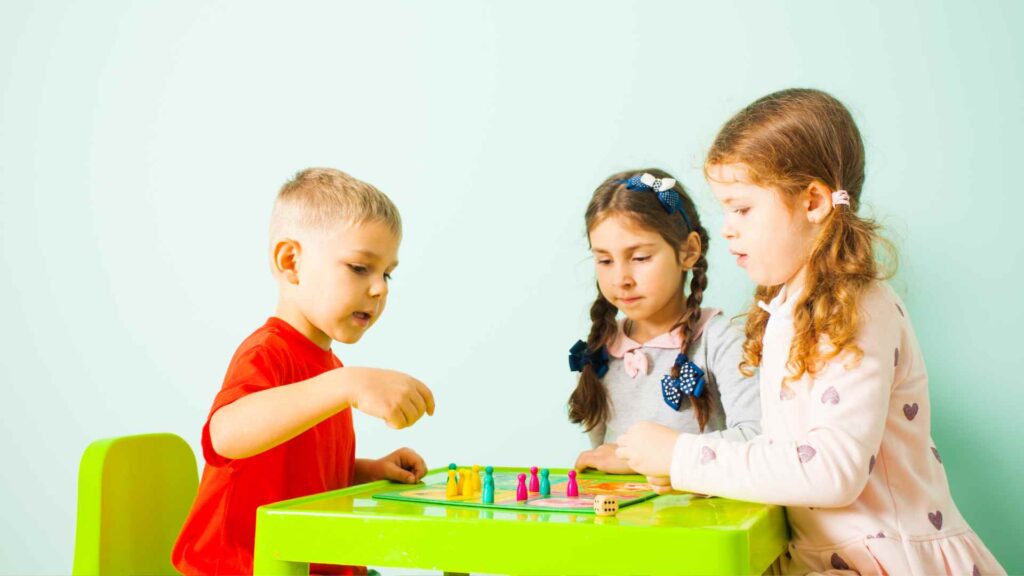
Technology-Assisted Games
Interactive Video Games
Video games offer a blend of entertainment and interactive experiences suitable for indoor play.
- Best Options for Family Play:
- Nintendo Switch: Games like Mario Kart, Super Mario Party, and Animal Crossing offer multiplayer fun.
- PlayStation and Xbox: Family-friendly titles include Minecraft, LEGO games, and Just Dance.
- Wii Sports: Active games like tennis, bowling, and golf promote physical activity.
- Tips for Healthy Screen Time:
- Set time limits and encourage breaks for physical activity.
- Choose games that promote teamwork, problem-solving, or physical movement.
Online Multiplayer Games
Engage in virtual playdates or connect with friends through online multiplayer games.
- Safe and Fun Options for Kids:
- Roblox: Offers a variety of games and activities suitable for different ages.
- Minecraft: Collaborative building and exploration game.
- Among Us: Social deduction game where players work together to uncover imposters.
Educational Apps and Games
Explore educational apps and games that make learning fun and interactive.
- Recommendations for Different Subjects:
- ABCmouse: Early learning app covering literacy, math, and more.
- Khan Academy Kids: Offers activities and lessons in math, reading, and social-emotional learning.
- Duolingo: Language learning app with interactive lessons for various languages.
Technology-assisted games provide diverse opportunities for learning and entertainment indoors, offering a blend of interactive experiences that cater to different interests and age groups.
They are ideal for enhancing digital literacy and promoting social interaction in a virtual setting.
Quiet and Calming Games
Storytime
Encourage creativity and relaxation with storytelling activities.
- How to Conduct Storytime:
- Gather in a cozy spot with blankets and pillows.
- Take turns telling stories or reading books aloud.
- Use props or puppets to enhance storytelling.
Art and Craft Stations
Set up art stations for creative expression and quiet play.
- Ideas for Art and Craft Activities:
- Drawing and Coloring: Provide coloring books, crayons, markers, and colored pencils.
- DIY Crafts: Use materials like paper, glue, scissors, and recycled items to create crafts.
- Painting: Use washable paints and brushes for artistic exploration.
Mindfulness and Yoga
Introduce mindfulness and relaxation techniques through simple yoga poses and activities.
- Yoga and Mindfulness Exercises:
- Basic Poses: Child’s pose, tree pose, and downward-facing dog.
- Breathing Exercises: Teach deep breathing and relaxation techniques.
- Guided Meditation: Use apps or videos for guided meditation suitable for kids.
Quiet games and activities provide opportunities for children to unwind, express themselves creatively, and develop mindfulness skills. They are perfect for promoting relaxation and fostering a peaceful environment indoors.
Role-Playing and Dramatic Play
Dress-Up Theater
Encourage imaginative play with a dress-up theater setup.
- Creating a Dress-Up Theater:
- Costumes: Provide a variety of costumes, hats, and accessories.
- Props: Include props like a pretend stage, microphone, and audience chairs.
- Script Ideas: Use storybooks or create simple scripts for kids to act out.
Puppetry and Puppet Shows
Promote storytelling and creativity through puppetry and puppet shows.
- Making and Using Puppets:
- DIY Puppets: Create puppets using socks, paper bags, or craft materials.
- Puppet Theater: Use a cardboard box or makeshift stage for performances.
- Themes and Storylines: Act out favorite stories, fairy tales, or create original scripts.
Role-Playing Games
Engage kids in interactive role-playing games that spark imagination and social skills.
- Popular Role-Playing Ideas:
- Doctor or Vet Office: Use toy medical kits and stuffed animals as patients.
- Restaurant or Café: Set up menus, take orders, and serve imaginary food.
- Superheroes or Fantasy Characters: Create costumes and act out heroic adventures.
Role-playing and dramatic play encourage creativity, social interaction, and storytelling skills in children.
These activities provide opportunities for self-expression and imaginative exploration, making indoor playtime enjoyable and enriching.
Family-Friendly Challenges and Competitions
Family Olympics
Create a mini-Olympics event at home with a variety of fun and active challenges.
- Setting Up the Family Olympics:
- Choose Events: Include activities like relay races, sack races, and long jump.
- Create Medals: Use paper or cardboard to craft medals for winners.
- Award Ceremony: Celebrate with an award ceremony and family cheers.
Puzzle and Board Game Challenges
Turn game night into a competitive and exciting event with puzzle and board game challenges.
- Challenge Ideas:
- Speed Puzzle Challenge: Race to complete a jigsaw puzzle against the clock.
- Board Game Tournaments: Compete in tournaments with different board games.
- Team Challenges: Form teams and collaborate on challenges or games.
Cooking or Baking Contests
Host a cooking or baking contest where creativity and culinary skills shine.
- How to Organize a Cooking/Baking Contest:
- Choose Themes: Select themes like cupcakes, pizza, or healthy snacks.
- Judging Criteria: Evaluate taste, presentation, and creativity.
- Prizes: Offer fun prizes or certificates for the winners.
Family-friendly challenges and competitions foster teamwork, friendly rivalry, and family bonding.
They provide opportunities for shared experiences and laughter, making indoor activities memorable and enjoyable for everyone involved.
Indoor Physical Challenges
Yoga Relay
Combine yoga poses with a relay race for a fun and active indoor challenge.
- How to Play Yoga Relay:
- Setup: Create a course with yoga mats or designated spots for each pose.
- Teams: Divide into teams and assign each member a yoga pose.
- Relay Race: Teams race to complete the yoga poses in sequence.
- Variations: Add challenges like balancing a bean bag or holding poses for longer times.
Indoor Mini-Golf
Create a mini-golf course using household items for a creative and challenging indoor activity.
- Setting Up the Course:
- Obstacles: Use books, cups, and other items as obstacles.
- Holes: Designate targets such as overturned cups or baskets as holes.
- Golf Equipment: Use a plastic golf club and lightweight balls or makeshift items.
Dance Off
Turn up the music and have a dance-off to showcase creativity and energy.
- How to Host a Dance Off:
- Music Selection: Choose upbeat songs with different styles and tempos.
- Judging Criteria: Evaluate creativity, style, and enthusiasm.
- Freestyle Sessions: Allow each participant to showcase their best dance moves.
- Group Dance: Create a choreographed dance routine as a family.
Indoor physical challenges provide opportunities for exercise, teamwork, and friendly competition. They promote active play and creativity while keeping everyone entertained and moving indoors.
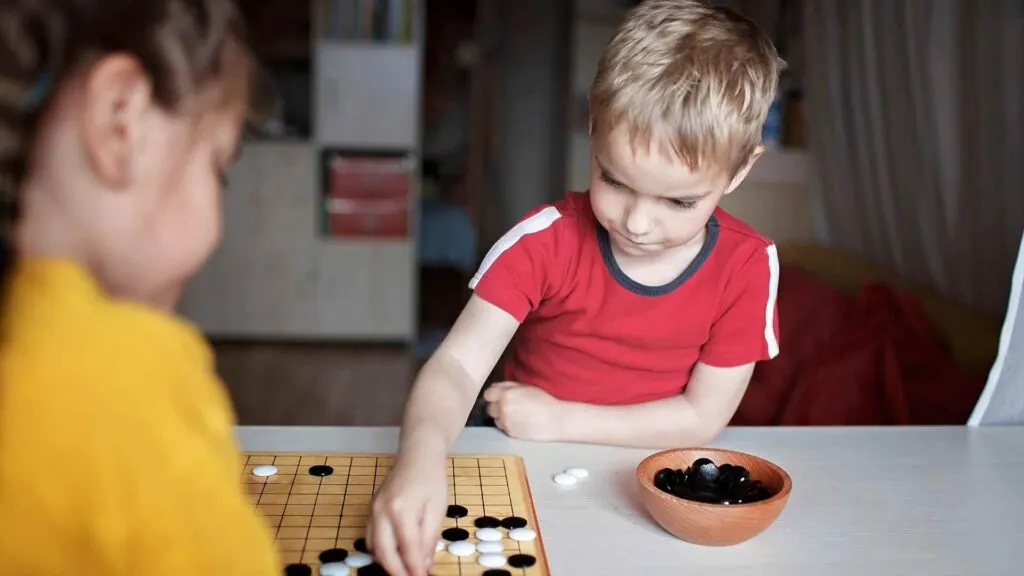
Classic Card and Board Games
Go Fish
A classic card game that’s easy to learn and fun for all ages.
- How to Play Go Fish:
- Objective: Collect sets of four cards by asking other players for specific cards.
- Gameplay: Players take turns asking for a card from another player’s hand.
- Scoring: Earn points by collecting sets; the player with the most sets wins.
Monopoly
A timeless board game of strategy, negotiation, and luck.
- Playing Monopoly:
- Setup: Distribute money, properties, and tokens to players.
- Gameplay: Buy properties, build houses and hotels, and collect rent from opponents.
- Winning: Bankrupt opponents or be the last player with money and properties.
Chess
A strategic board game that challenges thinking and planning skills.
- Chess Basics:
- Setup: Arrange pieces on the board with each side having 16 pieces.
- Gameplay: Move pieces strategically to capture the opponent’s pieces or checkmate the king.
- Rules: Learn the movement rules for each chess piece to play effectively.
Scrabble
A word game that tests vocabulary and strategic thinking.
- How to Play Scrabble:
- Setup: Draw seven letter tiles and place them on the rack.
- Gameplay: Form words crossword-style on the board, using letter tiles and earning points based on letter values.
- Winning: Score the most points by the end of the game by strategically placing high-value letters and using premium squares.
Classic card and board games provide opportunities for family bonding, strategic thinking, and friendly competition. They are perfect for indoor play and enjoyable for players of all ages, offering a variety of gameplay styles and challenges.
Creative Building and Construction Games
LEGO Building Challenges
Use LEGO bricks to engage in creative building challenges and competitions.
- Setting Up LEGO Challenges:
- Theme-Based Challenges: Create challenges based on themes like animals, vehicles, or cities.
- Time-Based Challenges: Set a time limit for building tasks to add excitement.
- Judging Criteria: Evaluate creativity, complexity, and adherence to the challenge theme.
Block Building
Explore imaginative construction with wooden or foam building blocks.
- Ideas for Block Building Activities:
- Free Build: Allow children to build anything they imagine using blocks.
- Architectural Challenges: Build bridges, towers, or complex structures with blocks.
- Collaborative Building: Work together to create a large-scale structure or cityscape.
Magnetic Tile Creations
Use magnetic building tiles to create geometric shapes and structures.
- Benefits of Magnetic Tiles:
- Enhance spatial awareness and fine motor skills.
- Explore principles of geometry and engineering through hands-on play.
- Build structures that can be easily dismantled and redesigned for continuous creativity.
Creative building and construction games foster problem-solving skills, spatial reasoning, and creativity in children. They provide opportunities for hands-on learning and imaginative exploration, making indoor playtime both educational and enjoyable.
Indoor Treasure Hunts
Pirate Treasure Hunt
Embark on a thrilling pirate-themed treasure hunt adventure indoors.
- Setting Up the Pirate Treasure Hunt:
- Treasure Map: Create a map with clues leading to hidden treasures.
- Pirate Props: Dress up with pirate hats, eyepatches, and costumes.
- Treasure Chest: Hide a treasure chest filled with small prizes or treats at the final destination.
Detective Mystery Hunt
Engage in a detective mystery hunt to solve clues and uncover secrets indoors.
- How to Organize a Detective Mystery Hunt:
- Clue Creation: Write or design clues that lead to the next location or puzzle.
- Mystery Themes: Choose themes like spy missions, missing items, or whodunit mysteries.
- Teamwork: Work together to decipher clues and solve the mystery.
Nature Scavenger Hunt
Bring the outdoors indoors with a nature-themed scavenger hunt.
- Creating a Nature Scavenger Hunt:
- Items to Find: List natural items like leaves, feathers, or pinecones to search for indoors.
- Educational Twist: Include facts or trivia about the items found during the hunt.
- Outdoor Simulation: Use indoor plants, pictures, or representations of outdoor elements.
Indoor treasure hunts provide excitement, teamwork, and problem-solving opportunities for children and families. They encourage exploration, creativity, and critical thinking while turning ordinary indoor spaces into thrilling adventure zones.
Music and Movement Games
Musical Chairs
A classic game that combines music and movement with friendly competition.
- How to Play Musical Chairs:
- Setup: Arrange chairs in a circle, one fewer than the number of players.
- Gameplay: Walk or dance around the chairs while music plays; when the music stops, players quickly find a chair.
- Elimination: Remove one chair after each round; the player left standing is out.
- Winner: The last player remaining wins the game.
Freeze Dance
An energetic game that encourages creativity and listening skills.
- Playing Freeze Dance:
- Setup: Play upbeat music and designate a dance area.
- Gameplay: Dance freely while the music plays; when the music stops suddenly, freeze in place.
- Variations: Add challenges like dancing in slow motion or dancing like animals.
Simon Says
A classic game of listening and following instructions.
- How to Play Simon Says:
- Instructions: One player (Simon) gives commands starting with “Simon says…” followed by an action.
- Response: Players only perform actions preceded by “Simon says”; if Simon doesn’t say “Simon says” and players perform the action, they’re out.
- Last Player Standing: The last player following instructions becomes the next Simon.
Dance Charades
Combine dance and acting skills for a lively and creative game.
- Playing Dance Charades:
- Setup: Write down different dance styles or actions on slips of paper and place them in a bowl.
- Gameplay: Players take turns picking a slip and performing the dance style or action while others guess.
- Team Play: Divide into teams and compete to guess the most dances correctly within a time limit.
Music and movement games promote physical activity, coordination, and creativity indoors. They are perfect for getting kids up and moving while having fun with friends and family.
Educational and Learning Games
Math Bingo
Combine learning with a classic game of Bingo focused on math skills.
- Playing Math Bingo:
- Setup: Create Bingo cards with math problems (e.g., addition, subtraction, multiplication) instead of numbers.
- Gameplay: Call out math problems, and players mark the answers on their Bingo cards.
- Learning Focus: Reinforce math facts and problem-solving skills while playing.
Spelling Bee
Challenge spelling abilities and vocabulary with a friendly Spelling Bee competition.
- Organizing a Spelling Bee:
- Word Lists: Prepare word lists appropriate for different age groups and difficulty levels.
- Competition Format: Call out words for participants to spell aloud; incorrect spellings lead to elimination.
- Practice Rounds: Conduct practice rounds to familiarize participants with the competition format.
Science Experiments
Explore scientific concepts through hands-on experiments and activities.
- Ideas for Indoor Science Experiments:
- Kitchen Chemistry: Create simple experiments using household items like vinegar, baking soda, or food coloring.
- Physics Demonstrations: Explore concepts like gravity, force, and motion with DIY experiments.
- Biology Activities: Study plants, animals, or the human body through observation and experiments.
Geography Quiz
Test knowledge of geography facts and world landmarks in a quiz-style game.
- How to Conduct a Geography Quiz:
- Question Preparation: Prepare questions about countries, capitals, landmarks, and geographical features.
- Quiz Format: Ask questions in multiple-choice or short-answer format; award points for correct answers.
- Interactive Learning: Encourage discussions and provide additional information about each topic covered.
Educational games provide opportunities for learning, skill development, and exploration of various subjects indoors. They stimulate curiosity, critical thinking, and creativity while making learning enjoyable and engaging for children of all ages.
